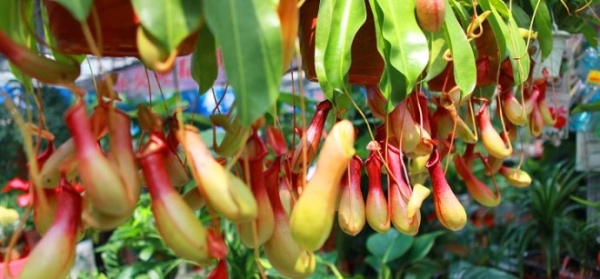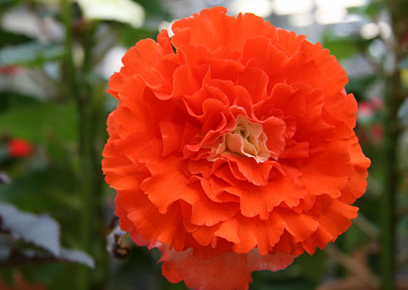Can pitcher plants be raised indoors?
If there are children and the elderly at home, they may mistakenly eat pitcher plants, and the branches and leaves of pitcher plants are highly toxic, so it is best not to breed them indoors. And pitcher plants give off an unpleasant stench when they bloom, and breeding in the bedroom gives off an unpleasant smell, affecting healthy sleep.

But if flower friends like pitcher plants very much, they can raise them in the courtyard balcony or in the courtyard, so it is very safe, neither poisoning nor affecting sleep and rest; and pitcher plants are a plant that needs to attach and grow. It must be attached to its plant in order to stand up, so when raising pitcher plants, it is best to set up brackets for pitcher plants to stand up and make them stand up.
Although the pitcher plant is poisonous, it still has medicinal value and can be used to treat lung dryness and cough. these need to go to a special hospital to follow the doctor's advice in order to be effective, do not eat by mistake!
How to raise pitcher plants the breeding methods and matters needing attention
Pitcher plant is a kind of plant that can catch worms. Some people will plant it in the balcony, courtyard and other places at home. Do you know how to raise pitcher plants? Today, let's talk about the breeding methods and matters needing attention of pitcher plants.
I. introduction of pitcher plants
Pitcher plant is the general name of all species of pitcher plant. It belongs to tropical insectivorous plants, and its origin is mainly in the tropics of the old world. It has a unique nutrient-absorbing organ-the insect cage, which is cylindrical in shape, the lower half is slightly inflated, and the mouth of the cage has a lid, so it is named because it is shaped like a pig cage.
The leaves of pitcher plants are complex in structure, with petioles, leaf bodies and tendrils. The tail of the tendril is enlarged and rolled back to form a bottle, which can prey on insects. The pitcher plant has racemes with small green or purple flowers and the vase at the top of the leaf is a tool for preying on insects. The cover of the bottle can separate the fragrance and attract insects. The mouth of the bottle is smooth, and the insects will be slipped into the bottle, drown by the liquid secreted from the bottom of the bottle, and decompose the nutrients and gradually digest and absorb them.
There are about 170 wild species of pitcher plants in the world, but there is only one species in Guangdong, China, and there are more than 1000 horticultural species. Although pitcher plants are widely distributed in Sanling Mountain and Leizhou in Guangdong Province, they are rarely used. It was not until the 1990s that the fine varieties of pitcher plants introduced from China were mainly used in flower shows.
2. Breeding methods of pitcher plants
Soil: loose, fertile and breathable rotten leaf soil or peat soil is better. A mixed substrate of peat soil, water moss, charcoal and fir sawdust is often used in pots.
Watering: pitcher plants are sensitive to water. Pitcher plants can only grow and develop normally under high humidity conditions. During the growing period, pitcher plants need to spray water frequently, 4 or 5 times a day. If the temperature changes greatly and is too dry, it will affect the formation of leaf cages.
Sunshine: the pitcher plant is an epiphytic plant, which often grows under the forest or on the north side of the rock. The natural condition is semi-overcast. Under the strong light in summer, the leaves must be shaded, otherwise the leaves are easy to burn and directly affect the development of the leaf cage. However, under dark conditions for a long time, the leaf cage forms slowly and small, and the color of the cage surface is dim.
Temperature: the suitable temperature for the growth of pitcher plant is 2530 ℃, 2130 ℃ from March to September, and 1824 ℃ from September to March of the following year. The winter temperature was not lower than 16 ℃, the plants below 15 ℃ stopped growing, and the leaf edges suffered frost damage when the temperature was below 10 ℃.
Fertilization: pitcher plants do not need special fertilization, because pitcher plants can usually feed on insects to transform nutrients, if pitcher plants have insects to eat, there is no need to apply fertilizer.
Insect pests: pitcher plants are often harmed by leaf spot and shell insects. Leaf spot disease was sprayed with 1000 times of 50% Dysen zinc wettable powder. The shell worm was sprayed with 2000 times of 40% dimethoate EC.
Pruning: the cage of the pitcher plant is a kind of abnormal leaf, so it will age and die like the leaves of other plants. Generally speaking, each cage can survive for several months under suitable conditions. When it has withered, it can be cut off to make the whole plant look more beautiful, but this is purely for the sake of beauty and has nothing to do with the health of the plant.
Matters needing attention in the cultivation of pitcher plants
1. The flowers of pitcher plants have no ornamental value, they are small and flat, and only a few varieties of flowers are more bright. in addition, pitcher flowers also give off a bad smell, so try not to breed them indoors as much as possible. the courtyard balcony is the best choice.
2. The pitcher plant is a vine, and it must be attached in order to stand, so it is necessary to set up a support for the pitcher plant. In order to set up the support, it is necessary to use larger flowerpots, on the other hand, larger flowerpots can hold more cultivation value, make the flowerpots stable and heavy, and can support large pitcher plants without being blown down by the wind.
More information on how to cultivate pitcher plants the correct method of raising pitcher plants
Pitcher plant is a rare carnivorous plant, it has a unique pitcher cage, the shape is particularly good-looking, now this kind of pitcher plant is mostly cultivated as an ornamental plant, but many people do not know much about the breeding method of pitcher plant. I don't know how to breed it most correctly. I will write out the correct breeding method of pitcher plant for a while. After you have read it, you will know how to breed pitcher plant.
Correct culture method of pitcher plant
1. Suitable soil should be selected for raising pitcher plants.
Usually, pitcher plants should choose suitable soil, it likes loose, fat and breathable soil, pot can choose peat soil and water moss and charcoal and other materials to mix. In addition, the breeding pitcher plant environment should also pay attention to, it is an epiphytic plant, like to grow in a semi-shady environment, especially in summer can not let it accept strong light.
2. Fertilizer and water management of cultured pitcher plants.
Usually want to raise pitcher plant, water and fertilizer management is very heavy, it is a kind of plant that is particularly sensitive to water, it can only grow and develop normally in a high humidity environment, and when it is in the peak growing season, it is best to spray water on the leaves four to five times a day. The pitcher plant has little demand for fertilizer, and the insects it usually preys on can be transformed into fertilizers for growth, but when it is raised indoors, pitcher plants have no insects to eat, so it is necessary to apply fertilizer in time.
3. Pest damage and pruning of pitcher plants
Pitcher plants will also have some diseases and insect pests during the breeding period, especially the high incidence of leaf spot disease. After it occurs, it can be sprayed with zinc wettable agents. In addition, if you want to improve the ornamental value of pitcher plants, pruning is also very important, especially its pig cages, that is, abnormal leaves, which will wither after a month or two. At this time, you can cut them directly, which will make the whole plant more beautiful.
- Prev

Maintenance methods of Begonia bulbosa
Watering Begonia likes the moist growth environment, but it is afraid of waterlogging, so it is best not to have stagnant water. When the weather is dry in summer, the air humidity should be increased by spraying water, watering should be reduced in autumn and winter in dormant period, and watering should also be reduced in the budding and flowering period of Begonia bulb.
- Next

Planting method of zedoary turmeric
Planting method of zedoary turmeric
Related
- Fuxing push coffee new agricultural production and marketing class: lack of small-scale processing plants
- Jujube rice field leisure farm deep ploughing Yilan for five years to create a space for organic food and play
- Nongyu Farm-A trial of organic papaya for brave women with advanced technology
- Four points for attention in the prevention and control of diseases and insect pests of edible fungi
- How to add nutrient solution to Edible Fungi
- Is there any good way to control edible fungus mites?
- Open Inoculation Technology of Edible Fungi
- Is there any clever way to use fertilizer for edible fungus in winter?
- What agents are used to kill the pathogens of edible fungi in the mushroom shed?
- Rapid drying of Edible Fungi

